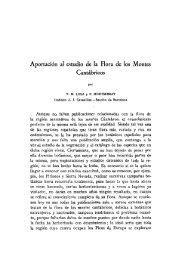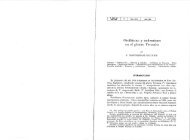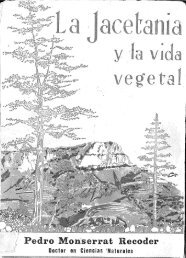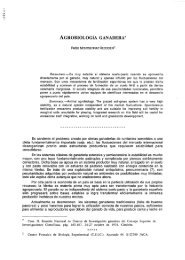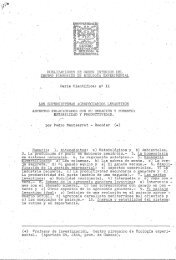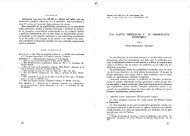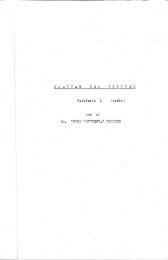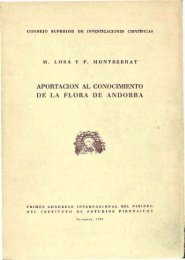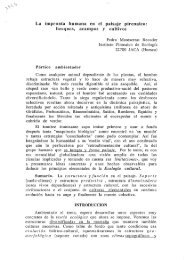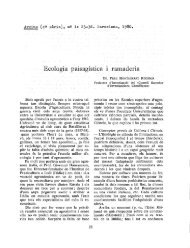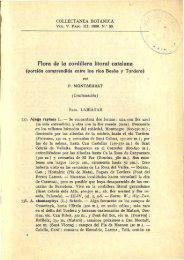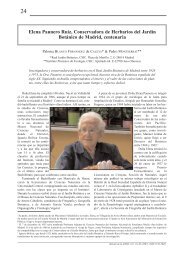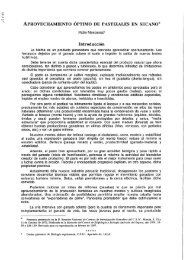62made up <strong>of</strong> hard-leaved grasses (Avenulamirandana, Festuca hystl'ix, F. <strong>in</strong>digesta, Koeleriavallesiana, ele.) toge<strong>the</strong>r wilh Cistaeeae and Fabaccae(Cislus, Halimiunl, Helianlhemwn, Tuberaria,As/raga/us, Genista occi<strong>del</strong>lfalis, G. pwnila, Medicago,Trifoliwn, etc.). Dry air and contrast<strong>in</strong>gtemperatures are characteristic <strong>of</strong> this environmentwhieh is epitomized by <strong>the</strong> juniper tree (Juniperus/hur!!era) so lypieal <strong>of</strong> lhis region, as are J. nauaand J. sab<strong>in</strong>a.Although <strong>the</strong> above vegelation is lypieal <strong>of</strong> <strong>the</strong>Cordillera Ibérica, Montañas de León, Sanabriaand lhe Carpelana between Somosierra andGredos, oak woods are also widespread, and lo alesser degree p<strong>in</strong>e forests (Sierra de Guadarrama,P<strong>in</strong>ar de Lillo <strong>of</strong> León prov<strong>in</strong>ee, Sierra de laDemanda, Cameros, Sierra <strong>del</strong> Moncayo andMonles Universales): <strong>the</strong>re are a few beeeh woodson slopes fae<strong>in</strong>g north-wesl wilh lheir eharaeteristiefrequent mists eaused by lhe eool<strong>in</strong>g <strong>of</strong> lheascend<strong>in</strong>g air currents. There are also extensivemoorlands, where lhe dom<strong>in</strong>anl planl is Callunavulgaris associatcd with El'ica australis and at timesVacc<strong>in</strong>unl myrtilfus and V. ulig<strong>in</strong>oswn. The prescnce<strong>of</strong> Erica arborea and Genista florida are<strong>in</strong>dieative <strong>of</strong> a habilat where <strong>the</strong>re is deep soil andunderground water.The Cameros (3a <strong>in</strong> Fig. 3.10). The environment<strong>of</strong> lhe Cameros belween Logroño and Soria(Calvo, 1977) can be taken as generally representativefor lhe eenlral mounta<strong>in</strong>s <strong>of</strong> Spa<strong>in</strong>. When lhecows lcave <strong>the</strong>ir w<strong>in</strong>ter stable, pregnant, <strong>the</strong>y reachCameros rough pastures where <strong>the</strong>y give birth, andlhey deseend lo lhe village when <strong>the</strong>y sense <strong>the</strong>approaeh <strong>of</strong> lhe lirsl heavy snowfall. The Cameranaeow or P<strong>in</strong>ariega, was perfeetly adapted lo lhepoor qualily <strong>of</strong> lhe graz<strong>in</strong>gs, seattered belweensmall woods and healhland, where eaeh eow has itshaunt, gives birth and retums home with ils ealf.Sheep graze on <strong>the</strong> drier slopes, and transhumantsare frequent <strong>in</strong> this part <strong>of</strong> Cameros.The phytosoeiology <strong>of</strong> lhe Cameros Mounta<strong>in</strong>swilh <strong>grassland</strong>s has been deseribed by Mendiola(1983).Those meadows whieh need eutt<strong>in</strong>g only once ayear are loeated near centres <strong>of</strong>habilation; here lhepasiego and lhe borda <strong>of</strong> <strong>the</strong> Pyrenees and <strong>the</strong>Cantabrian Mounta<strong>in</strong>s are virtualIy nOll-existent.Inslead lhere are meadows <strong>of</strong> Arrhena<strong>the</strong>retaliaPEDRO MONTSERRAT ,ud FEDERICO FILLATeharaeterized by an abundanee <strong>of</strong> Malva moscha/a.Near <strong>the</strong> páramo, where lhe heathland is driest,are found oak woods <strong>of</strong> Quercus pyrellaicG, anexeellent oak for forage. It provides serub forgraz<strong>in</strong>g, with shoots c. 10 lo 25 cm <strong>in</strong> length, andabounds <strong>in</strong> Zamora, Avila-Segovia, Sierra deGuadalupe, etc.Meadows <strong>in</strong> lhe high mounla<strong>in</strong>s <strong>of</strong> Teme) (3b <strong>in</strong>Fig. 3.10). In <strong>the</strong> high mounta<strong>in</strong>s <strong>of</strong> Teruel(1500-2000 m) p<strong>in</strong>e forests predom<strong>in</strong>ate (P<strong>in</strong>uss)'/l'eSfris) <strong>in</strong>terealated wilh small woods <strong>of</strong> Quercusp)'renaiea and hazel (Cor)'/us al'el/ana) <strong>in</strong> <strong>the</strong>Sierra de Gúdar-Val<strong>del</strong><strong>in</strong>ares, where <strong>the</strong> soil iseooler and rieher. The meadow-Iands <strong>of</strong> thiseastern zone have been famous s<strong>in</strong>ce ancient times(Asso, 1779) with pastures where Fabaeeae aredom<strong>in</strong>anl (As/ragalus danieus, Medieago sufjruticosa,Onobrychis hispanica, .Ononis cris/ata, etc.).The paslures <strong>of</strong> <strong>the</strong> Monles Universales areseattered belween abundant p<strong>in</strong>e forests and are <strong>of</strong>a poorer qualily than those mentioned above.Methods used for ealtle farm<strong>in</strong>g were once verysimilar lo those found <strong>in</strong> <strong>the</strong> Cameros, bulnowadays exploitation for timber takes preeedenee.Sorne <strong>of</strong> lhe villages <strong>in</strong> lhe Sierra deAlbarracín keep f10eks <strong>of</strong> transhumanl mer<strong>in</strong>osheep whieh w<strong>in</strong>ler <strong>in</strong> La Mancha (Mesta deAlbarracín). In <strong>the</strong> mounta<strong>in</strong>s where soil is gravellyor sandy, Cal/una vulgaris, Cisfus laurifolius andHalimium viscosum have <strong>in</strong>vaded those pastureswhieh have been bumt olf. In <strong>the</strong>se zones goats are<strong>the</strong> ehief graz<strong>in</strong>g animal. A monograph on <strong>the</strong>se<strong>grassland</strong>s has been published by Gómez (1982).Meadows and <strong>grassland</strong> <strong>in</strong> <strong>the</strong> Carpetana Mounta<strong>in</strong>s<strong>of</strong> Ceulral Spa<strong>in</strong> (3e <strong>in</strong> Fig. 3.10). The Carpetanamounta<strong>in</strong> eha<strong>in</strong> (Sierra M<strong>in</strong>istra, 1200 m; Somosierra,2000 m; Guadarrama, 2400 m) presents apieture <strong>of</strong> various extensive glacis slop<strong>in</strong>g gentlydown towards <strong>the</strong> Castillian Meseta. The relativelyfertile deep soils (bardal soils) are most suilable forestablishmenl <strong>of</strong> meadows and green paslure-landdur<strong>in</strong>g thc summer. Where it is drier, as <strong>in</strong> Segovia,<strong>the</strong>re are woods <strong>of</strong> evergreen oak (Quereus ro/undifolia)and pastures dotted with Juniperus /"urifera.Towards Somosierra <strong>the</strong>re are graz<strong>in</strong>gs on deep soilwhieh are now overgrown wilh lhe braeken fem, an<strong>in</strong>dex <strong>of</strong> both <strong>the</strong>ir abandonment and <strong>the</strong> deerease<strong>in</strong> livestoek aetivity.
THE SYSTEMS OF GRASSLAND MANAGEMENT IN SPAINIn lhe Escorial and Guadarrama <strong>the</strong> meadowson dccp soil [ICC cut <strong>in</strong> spr<strong>in</strong>g and <strong>in</strong>tensivelygrazed; lhe ash (Fl"axilluS allguslifolia) borders<strong>the</strong>se meadows. Where QuerClls pyrellalca grows itis an <strong>in</strong>dication <strong>of</strong> permeable soil, while evergreenoak and JUllipel'us oxycedrus grow <strong>in</strong> <strong>the</strong> drierenclaves al higher altiludes close to 800-1000 m(Rivas Martínez, 1982).The Avileña cattle are characterislic <strong>of</strong> <strong>the</strong>semounta<strong>in</strong>s, and are well represented <strong>in</strong> <strong>the</strong> Sierrade Gredos and its foothills. Fesluca elegallsgrow<strong>in</strong>g on <strong>the</strong> convexities is <strong>the</strong> dom<strong>in</strong>antsummer plant <strong>of</strong> lhe upland paslures, whileCampanulo-Nardion communities grow <strong>in</strong> <strong>the</strong>damper hollows (Rivas Mart<strong>in</strong>ez, 1963). Mov<strong>in</strong>gsoulhwards <strong>the</strong> change <strong>of</strong>level is extremely abrupt,and this contrasled landscape was advanlageous to<strong>the</strong> Avileña breed, which make a short lranshumancelo <strong>the</strong> Mediterranean type <strong>of</strong> pastures <strong>of</strong>Arenas de San Pedro and lhe Tiétar Valley; <strong>in</strong><strong>the</strong>se w<strong>in</strong>ter<strong>in</strong>g zones, Poa bulbosa and Trifoliumsubterraneum are abundant.The Mesla lype <strong>of</strong> animal husbandry <strong>in</strong> León andCastillaThis is a sheep system which has been <strong>in</strong>fiuentialfrom mediaeval times to lhe present day, and it ischaracteristic <strong>of</strong> lhe nor<strong>the</strong>m Meseta. This zonewas un<strong>in</strong>habited for several centuries dur<strong>in</strong>g <strong>the</strong>Reconquista (Fig. 3.5E), thus favour<strong>in</strong>g <strong>the</strong> movement<strong>of</strong> enormous flocks.In <strong>the</strong> par! which was reconquered before <strong>the</strong>10th century and colonized by freemen, <strong>the</strong>dom<strong>in</strong>ant breed <strong>of</strong> sheep is lhe Churra, useful farmilk and with rough wool. The landscape is one <strong>of</strong>heathlands and criss-crossed by wide valleys <strong>of</strong>deep soil favour<strong>in</strong>g <strong>the</strong> establishmenl <strong>of</strong> meadows.Flocks <strong>of</strong> 100 to 140 sheep also graze on <strong>the</strong>stubble <strong>of</strong> <strong>the</strong> crops sown <strong>in</strong> <strong>the</strong> area, and on o<strong>the</strong>rforage crops sown lraditionalIy for work animals.The resident fiocks <strong>of</strong> milk sheep have orig<strong>in</strong>atedhere.The dom<strong>in</strong>anl breed <strong>of</strong> sheep on lhe resl <strong>of</strong> <strong>the</strong>Meseta is <strong>the</strong> Entref<strong>in</strong>a Castellana, used for bothlheir meat and milk. Floeks <strong>of</strong> about 200 sheepgraze <strong>in</strong> <strong>the</strong> area all <strong>the</strong> year round. Here one mustdist<strong>in</strong>guish between lwo pr<strong>in</strong>cipal pattems: that <strong>in</strong><strong>the</strong> west assoeiated with extensive wooded pastureland,and <strong>the</strong> eastern pattern, where moorland onlimy soil is suilable for lhe cultivation <strong>of</strong> sa<strong>in</strong>fo<strong>in</strong>.The w<strong>in</strong>lers are long, and, while graz<strong>in</strong>g stillcont<strong>in</strong>ues <strong>in</strong> same <strong>of</strong> <strong>the</strong> meadows border<strong>in</strong>gwatereourses, feed<strong>in</strong>g is supplemenled by haymade from sa<strong>in</strong>fo<strong>in</strong> and luceme. The moorlandsheep graze also on <strong>the</strong> stubble which rema<strong>in</strong>s afterharvest<strong>in</strong>g sa<strong>in</strong>fo<strong>in</strong> and lucerne, and this ensuresthal <strong>the</strong> meadows ly<strong>in</strong>g along lhe watercoursecont<strong>in</strong>ue lo be productive.When <strong>the</strong> severe w<strong>in</strong>ter conditions <strong>of</strong> <strong>the</strong> páramoprcvail, orre f<strong>in</strong>ds <strong>in</strong> this zone (Sierra M<strong>in</strong>istra,Mol<strong>in</strong>a de Aragón, etc.) <strong>the</strong> hardy Ojalada Sorianabreed <strong>of</strong> sheep, a brancl! <strong>of</strong> <strong>the</strong> Ibérico stock. To<strong>the</strong> southwest, <strong>in</strong> La Alcarria, yel ano<strong>the</strong>r hardierbreed <strong>of</strong>sheep is found, lhe Alcarreña, a branch <strong>of</strong><strong>the</strong> Enlref<strong>in</strong>a especially adapted to mounta<strong>in</strong> areas(see Fig. 3.6A).The lack <strong>of</strong> emphasis on wool production <strong>in</strong>sheop farm<strong>in</strong>g is due lo lhe runn<strong>in</strong>g down <strong>of</strong> lhewool <strong>in</strong>duslry and <strong>the</strong> collapse <strong>of</strong> <strong>the</strong> Mestaorganization. The BHonrado Concejo de la Mesta"was arig<strong>in</strong>ally created and supported by <strong>the</strong> K<strong>in</strong>g <strong>in</strong>1273 (Kle<strong>in</strong>, 1964) <strong>in</strong> order lo lake advantage <strong>of</strong>lheproduction <strong>of</strong> enormous quantities <strong>of</strong> wool obta<strong>in</strong>ed[rom <strong>the</strong> mer<strong>in</strong>o. This association concernedwilh sheep farm<strong>in</strong>g crealed wealth for lhe RoyalTreasury, and was lhus encouraged lo lhe detriment<strong>of</strong> a more general agricultural policy (cultivation <strong>of</strong>arable land). However, lhe <strong>in</strong>crease <strong>in</strong> populaliondur<strong>in</strong>g <strong>the</strong> 18lh century and <strong>the</strong> collapse <strong>of</strong> <strong>the</strong>foreign markel caused lhe loss <strong>of</strong> <strong>the</strong>se privilegesand lheir legal abolition <strong>in</strong> 1836 (Garda, 1978).Figure 3.10 shows lhe great sheep lrails <strong>of</strong> <strong>the</strong>cenlral-westem area where <strong>the</strong> Castillan Mesta wasimportan!. To <strong>the</strong> east lhere were lhe Mesla deAlbarradn and <strong>the</strong> Casa de Ganaderos de Zaragozaorganiz<strong>in</strong>g <strong>the</strong> Montes Ibéricos and EbroValley transhumances. The shorl graz<strong>in</strong>g providedby Poa bulbosa and Trifolillln sublerralleum (RivasGoday and Rivas Martínez, 1963) is good for lhemer<strong>in</strong>o sheep. This type <strong>of</strong> paslure-land is pr<strong>in</strong>cipallyconf<strong>in</strong>ed lo lhe west (end <strong>of</strong> lhe arrows <strong>in</strong>Fig.3.l0) and has a high w<strong>in</strong>ler production as<strong>in</strong>dicaled by <strong>the</strong> ra<strong>in</strong>fall maps (Fig. 3.3). The longjoumey <strong>in</strong>volved <strong>in</strong> lranshumance enables <strong>the</strong>sheep lo lake advanlage <strong>of</strong> <strong>the</strong> shart loughpastures <strong>of</strong> <strong>the</strong> páramos and <strong>of</strong> <strong>the</strong> limestonesubcanlabrian mounta<strong>in</strong>s <strong>of</strong> León, Palencia andSoria. This is why <strong>the</strong> wide sheep trails, with areasset aside for rest<strong>in</strong>g, have persisled <strong>in</strong> all <strong>the</strong>ircomplexity until <strong>the</strong> present day.63



